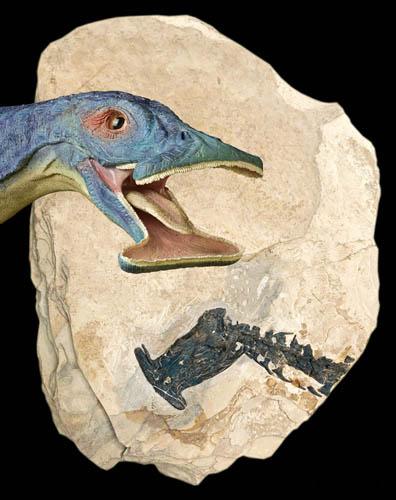Scientists report world's first herbivorous filter-feeding marine reptile
Some strange creatures cropped up in the wake of one of Earth's biggest mass extinctions 252 million years ago. In 2014, scientists discovered a bizarre fossil--a crocodile-sized sea-dwelling reptile,
Atopodentatus unicus, that lived 242 million years ago in what today is southwestern China. Its head was poorly preserved, but it seemed to have a flamingo-like beak. However, in a paper published May 6 in Science Advances, Dr. LI Chun, Institute of Vertebrate Paleontology and Paleoanthropology (IVPP) of the Chinese Academy of Sciences, and his international team described two new specimens and revealed what was really going on--that "beak" is actually part of a hammerhead-shaped jaw apparatus, which it used to feed on plants on the ocean floor. It's the earliest known example of an herbivorous marine reptile.
These two newly discovered specimens of Atopodentatus were collected from the Middle Triassic (Anisian) Guanling Formation of Luoping County, Yunnan Province, southwestern China. The new specimens clearly demonstrate that rather than being downturned, the rostrum was developed into a "hammerhead" with pronounced lateral processes formed by the premaxillae and maxillae in the upper jaw and mirrored by the dentary in the lower jaw, said the team.
"We confirm the presence of fine and densely packed needle-shaped teeth in the ramus of the dentaries and maxillae, but the premaxillary teeth are arranged along the anterior edge of the element and are more robust and peg-like in form", said lead author LI Chun.
The wide jaw of Atopodentatus was shaped like a hammerhead, and along the edge, it had peg-like teeth. Then, further into its mouth, it had bunches of needle-like teeth. "That arrangement wouldn't have been too useful for chewing prey", said study co-author Olivier Rieppel, Field Museum of Natural History, "It's more likely that Atopodentatus used its front teeth to nip algae or other plants from rocky surfaces and then, with its mouth closed, forced mouthfuls of water through its side teeth, which acted as a filter trapping the plants and letting the water back out, like how whales filter-feed with their baleen".
Atopodentatus is thus the oldest known vegetarian among marine reptiles. It is older than other marine animals that ate plants with a filter-feeding system by about eight million years, said the team.
Atopodentatus appeared during the Triassic Period relatively soon after the biggest mass extinction of species in Earth's history, illustrating that life recovered and diversified more quickly than previously thought. Other oddball creatures also swam the seas at the time, including a reptile called Dinocephalosaurus whose neck comprised half of its 17-foot (5.25 meters) length.
"Atopodentatus, about 9 feet (2.75 meters) long, lived in a shallow sea in China's Yunnan province alongside fish and other marine reptiles, said study co-author CHENG Long, Wuhan Centre of China Geological Survey, "When thinking of hammerhead creatures, sharks may come to mind. But Atopodentatus' hammerhead feature differed in location and function from the sharks, whose eyes are on the end of lateral extensions on their head."
"Overall, the creature is so unusual that it's difficult to tell where it fits on the reptile family tree", said Dr. Nicholas Fraser, co-corresponding author of the study, National Museums Scotland, "Because its fossils are relatively complete, paleontologists will probably need to unearth fossils of yet-to-be-discovered relatives to better figure this out. In the meantime, Atopodentatus seems to be most closely related to the plesiosaurs, the typically long-necked marine reptiles that often were top predators in dinosaur-era oceans."
Source: Chinese Academy of Sciences Headquarters
BİOLOGY NEWS
-
RNA from Trained Aplysia Can Induce an Epigenetic Engram for Long-Term Sensitization in Untrained Aplysia.
-
HOW WE BECOME HAPPY
-
More tomatoes, faster: Accelerating tomato engineering
-
Purest yet liver-like cells generated from induced pluripotent stem cells
-
Legions of nanorobots target cancerous tumors with precision
-
CRISPR gene editing reveals new therapeutic approach for blood disorders
-
Quantum dots with impermeable shell: A powerful tool for nanoengineering
-
Thousands on one chip: New method to study proteins
-
Gene Drive Technology: Where is the future?
-
Four newly identified genes could improve rice
-
Watching the luminescent gene switch
-
DNA damage by ultrashort pulses of intense laser light
-
Mantis shrimp inspires next generation of ultra-strong materials
-
Specialized life forms abound at Arctic methane seeps
-
Ocean warming and acidification impact on calcareous phytoplankton



